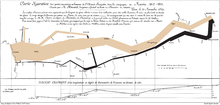Russian Winter
|
Read other articles:

جيري فان دايك (بالإنجليزية: Jerry Van Dyke) معلومات شخصية الميلاد 27 يوليو 1931 [1][2] دانفيل الوفاة 5 يناير 2018 (86 سنة) [2] هت سبرينغز سبب الوفاة قصور القلب مواطنة الولايات المتحدة إخوة وأخوات ديك فان دايك أقرباء باري فـان ديك (أبناء الإخوة)شون فا�…

American-Canadian businessman Ed Mirvish OC CBE OOntEd Mirvish, 2006BornYehuda Edwin Mirvish(1914-07-24)July 24, 1914Colonial Beach, Virginia,United StatesDiedJuly 11, 2007(2007-07-11) (aged 92)Toronto, Ontario, CanadaOther namesHonest EdOccupation(s)Founder, chair and CEO of Honest Ed'sChildrenDavid Mirvish[1] Yehuda Edwin Honest Ed Mirvish, OC CBE OOnt (July 24, 1914 – July 11, 2007)[2] was an American-Canadian businessman, philanthropist and th…

迪奥斯达多·马卡帕加尔Diosdado Pangan Macapagal第9任菲律賓總統任期1961年12月30日—1965年12月30日前任卡洛斯·P·加西亚继任费迪南德·马科斯第6任菲律賓副總統任期1957年12月30日—1961年12月30日前任卡洛斯·P·加西亚继任伊曼纽尔·佩莱斯 个人资料出生(1910-09-28)1910年9月28日 美屬菲律賓馬尼拉逝世1997年4月21日(1997歲—04—21)(86歲) 菲律賓馬卡迪墓地 菲律賓馬卡迪達義市英雄�…

Fantasy novel The Cygnet and the Firebird Cover of first editionAuthorPatricia A. McKillipCover artistJohn HoweCountryUnited StatesLanguageEnglishSeriesCygnet seriesGenreFantasyPublisherAce BooksPublication date1993Media typePrint (hardcover)Pages233ISBN0-441-12628-6Preceded byThe Sorceress and the Cygnet The Cygnet and the Firebird is a fantasy novel by Patricia A. McKillip, a sequel to her earlier novel The Sorceress and the Cygnet. Despite a mixed reception, it was nomina…

Not to be confused with Science Express, which provides advance electronic publication of selected Science papers. Science Express 2014 logo The Science Express is a mobile scientific exhibition for children mounted on a train which travels across India. The project was launched on 30 October 2007 at the Safdarjung railway station, Delhi by the Department of Science and Technology (DST), Government of India. Although open to all, the project primarily targets students and teachers. As of 2017 …

2016年美國總統選舉 ← 2012 2016年11月8日 2020 → 538個選舉人團席位獲勝需270票民意調查投票率55.7%[1][2] ▲ 0.8 % 获提名人 唐納·川普 希拉莉·克林頓 政党 共和黨 民主党 家鄉州 紐約州 紐約州 竞选搭档 迈克·彭斯 蒂姆·凱恩 选举人票 304[3][4][註 1] 227[5] 胜出州/省 30 + 緬-2 20 + DC 民選得票 62,984,828[6] 65,853,514[6] 得…

此條目需要补充更多来源。 (2021年7月4日)请协助補充多方面可靠来源以改善这篇条目,无法查证的内容可能會因為异议提出而被移除。致使用者:请搜索一下条目的标题(来源搜索:美国众议院 — 网页、新闻、书籍、学术、图像),以检查网络上是否存在该主题的更多可靠来源(判定指引)。 美國眾議院 United States House of Representatives第118届美国国会众议院徽章 众议院旗帜…

Magnetic tape-based data storage technology LTOA 400 GB LTO-3 cassette by SonyMedia typeMagnetic tapeCapacityUp to 18 TBDeveloped byLTO Consortium (Hewlett Packard Enterprise, IBM, Quantum)Manufactured byFujifilm, Sony (tapes)IBM (drives)Dimensions102.0 × 105.4 × 21.5 mm(4.0 in. x 4.1 in. x 0.8 in.)UsageArchival storageReleased2000 Linear Tape-Open (LTO), also known as the LTO Ultrium format,[1] is a magnetic tape data storage technology used for backup, data archiving, and d…

Alamgir KabirBorn(1938-12-26)26 December 1938Rangamati, Bengal Presidency, British India[1]Died20 January 1989(1989-01-20) (aged 50)Pabna, BangladeshAlma materDhaka CollegeUniversity of DhakaOxford UniversityOccupationfilm makerSpouse(s)Monjura Ibrahim (1968-1975; divorced) Jayasree Kabir (1975-1989; death)Children3AwardsIndependence Day Award (2010)[2] Alamgir Kabir (26 December 1938 – 20 January 1989) was a Bangladeshi film director and cultural activist.[3]…

Daniel BernoulliDaniel BernoulliLahir8 Februari 1700Groningen, BelandaMeninggal8 Maret 1782(1782-03-08) (umur 82)Basel, SwissDikenal atasPrinsip Bernoulli, Teori kinetika gas, TermodinamikaTanda tangan Daniel Bernoulli adalah seorang seorang matematikawan dan fisikawan Swiss.[1] Salah satu pemikirannya yang penting dalam bidang fisika adalah prinsip Bernoulli pada tabung arus yang digunakan untuk pengukuran kecepatan aliran fluida karena tekanan.[2] Masa kecil Daniel Bernoul…

For the unincorporated communities, see Big Bend, Butte County, California and Big Bend, Placer County, California. Place in California, United StatesBig Bend Madesi Valleyunincorporated areacensus-designated placeLocation in Shasta County and the state of CaliforniaCoordinates: 41°1′11″N 121°54′28″W / 41.01972°N 121.90778°W / 41.01972; -121.90778Country United StatesState CaliforniaArea[1] • Total5.82 sq mi (15.08 …

ملخص معلومات الملف الوصف الملك فيصل الثاني ملك العراق 1957 المصدر https://www.tumblr.com/search/iraqi%20kingdom التاريخ 1957 المنتج غير معروف الإذن(إعادة الاستخدام) انظر أدناه. ترخيص هذه صورةٌ لشخصية متوفاة وهي محميةٌ بحقوق التأليف والنشر. في ويكيبيديا يسمح برفع واستخدام صور للشخصيات المتوفاة تحت �…

Organic reaction Shapiro reaction Named after Robert H. Shapiro Reaction type Coupling reaction Identifiers Organic Chemistry Portal shapiro-reaction RSC ontology ID RXNO:0000125 The Shapiro reaction or tosylhydrazone decomposition is an organic reaction in which a ketone or aldehyde is converted to an alkene through an intermediate hydrazone in the presence of 2 equivalents of organolithium reagent.[1][2][3] The reaction was discovered by Robert H. Shapiro in 1967.[4…

Ring-shaped bread product For other uses, see Bagel (disambiguation). BagelSesame bagelAlternative namesBajgiel, beigel, beyglTypeBreadPlace of originPolandRegion or stateEurope, North America, IsraelAssociated cuisineJewish, Polish, American, Canadian, and IsraeliCreated byJewish communities of PolandServing temperatureRoom temperatureMain ingredientsWheat doughVariationsMontreal-style bagel, pizza bagel, bagel toast Media: Bagel A bagel (Yiddish: בײגל, romanized: beygl; Poli…

IV Copa Mundial de Fútbol Playa FIFAMarsella 2008 2008 FIFA Beach Soccer World Cup Sede Francia Fecha 17 de julio de 200827 de julio de 2008 Cantidad de equipos 16 Podio • Campeón• Subcampeón• Tercer lugar• Cuarto lugar Brasil Italia Portugal España Partidos 32 Goles anotados 258 (8,32 por partido) Goleador Madjer (13 goles) Balón de Oro Amarelle Mejor portero Roberto Valeiro Premio juego limpio Rusia La Copa Mundial de Fútbol Playa de FIFA 2008 fue la cuarta edic…

1953 film Everything for FatherActress Johanna Matz and director Karl HartlDirected byKarl HartlWritten byKarl HartlHugo Maria Kritz [de]Produced byLuggi WaldleitnerStarringJohanna MatzCurd JürgensPeer SchmidtCinematographyOskar SchnirchEdited byWalter FredersdorfMusic byLotar OliasProductioncompanyVita-FilmDistributed byDeutsche London-FilmRelease date 22 December 1953 (1953-12-22) Running time92 minutesCountryWest GermanyLanguageGerman Everything for Father (German…

1987 English local election This article relies largely or entirely on a single source. Please help improve this article by introducing citations to additional sources.Find sources: 1987 Worthing Borough Council election – news · newspapers · books · scholar · JSTOR (December 2023) 1987 Worthing Borough Council election ← 1986 7 May 1987 (1987-05-07) 1988 → 12 out of 36 seats to Worthing Borough Council19 seats needed …

Skeireins (Goth: 𐍃𐌺𐌴𐌹𐍂𐌴𐌹𐌽𐍃; IPA: [ˈskiːriːns]) adalah monumen bahasa Goth terpanjang dan terpenting setelah Alkitab bahasa Goth terjemahan Ulfilas. Terdiri dari 8 fragmen yang memuat komentari Injil Yohanes. Diduga asalnya terdiri dari 78 lebih lembaran perkamen. Nama Nama naskah ini berasal dari sarjana Jerman abad ke-19, Hans Ferdinand Massmann, yang pertama kali menerbitkan edisi komprehensif dan baik dari naskah ini. Skeireins berarti penjelasan dalam b…

2017 studio album by KhalidAmerican TeenStudio album by KhalidReleasedMarch 3, 2017Studio Various Beacon Hill Recording Studio (El Paso, TX)Golden Age (Los Angeles, CA)Body High Studios (Los Angeles, CA)Gower House (Los Angeles, CA)Temple Base Studios (Los Angeles, CA)Black Wax Studio (New York, NY)The Premises (London, United Kingdom)Sony/ATV Studios (London, United Kingdom) GenreR&Bteen popLength54:37LabelRight HandRCAProducerSyk Sense (also exec.)Alfredo GonzalezBryan MedinaDaniel…

Stratford-at-Bow redirects here. For the town in West Ham, see Stratford, London. Human settlement in EnglandBowFormer Bryant and May match factoryBowLocation within Greater LondonPopulation27,720 (2011 census Bow East and Bow West wards)[1]OS grid referenceTQ365825• Charing Cross4.6 mi (7.4 km) WLondon boroughTower HamletsCeremonial countyGreater LondonRegionLondonCountryEnglandSovereign stateUnited KingdomPost townLONDONPostcode …



